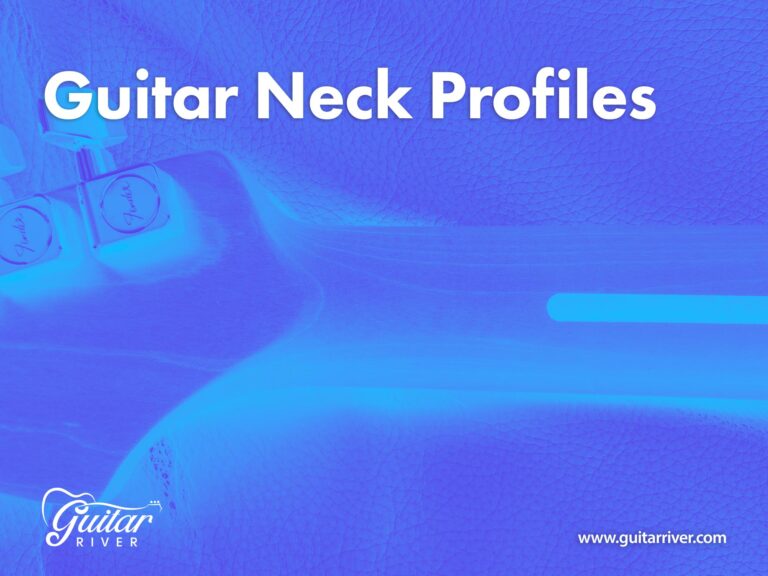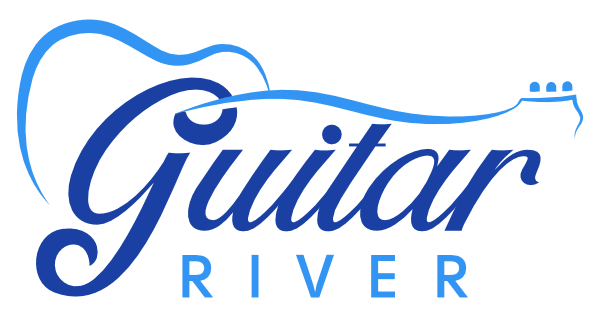Guitar River is reader-supported. We may earn a commission when you make a purchase using the links on our site.
Learn more.
Guitar Neck Shapes Explained: How It Affects Playability

Your guitar neck profile is an essential aspect of your guitar. It’s the part you interact with most when playing, so it’s critical to make sure your guitar has a neck that feels comfortable and suits your style of playing.
Different neck shapes determine how big the neck is and affect playability. The most common guitar neck shapes, also known as neck profiles, are C, U, V, and D. The C shape is the most prevalent neck profile. The U-neck profile is the thickest, D is the thinnest, and C is somewhere between.
In this blog post, we’ll explore the different guitar neck shapes, so you know what to look for when buying your next guitar. Read on to find out why you should understand guitar neck profiles, especially when shopping online.
What Is A Guitar Neck Profile?
A guitar neck profile refers to the shape of the neck cross-section. If you took your guitar neck and sliced it like a stick of butter, you would have wooden pieces almost flat on one side and round on the other.
The shape of this neck cross-section is the neck profile. These shapes are often described with the letters C, D, U, and V. This is just a shortcut to explain the profile shape.
How the neck feels is most important to you as a guitar player. It doesn’t matter so much what the exact shape is. Still, it’s helpful to understand the differences between the different guitar neck profiles.
In The Beginning, All Necks Were Chunky
Electric guitar necks were thicker in the early days of guitar design.
In the 1950s and earlier, guitar necks were more substantial. The thicker neck provided stability and was closer in size to acoustic guitar necks.
Gradually, thinner designs became more popular as musical styles evolved. Neck profile shapes were refined from the thicker “U” shape to a more modern “C” shape.
Starting with the thickest neck profile, our first stop in the neck shape alphabet is the letter “U.”
U-Shape Neck
The U-shape neck profile is our chunkiest neck profile. The U-shaped neck is sometimes called a “baseball bat” or “fat” neck. Don’t worry; the neck won’t be offended if you call it fat.
Featured on vintage Telecasters, the early Broadcaster, and vintage Les Pauls, the U-shape neck profile is so-called because it looks a bit like the letter U.
Like the C, it’s round on the bottom but with more volume. The “shoulders,” or the area where the neck meets the fretboard, are more prominent.
If you like a more substantial guitar neck, this may be the neck profile for you. It may not be your choice if you favor fast and technical playing, but it’s great for playing chords and rhythm and for those with large hands.
C-Shape Neck
The C-shaped neck profile is the standard neck profile that you will find on most modern guitars. It features a gradual curve and smaller shoulders than the U-neck profile. The C-neck profile can be described as an oval cut in half.
It’s very comfortable for your hand and is somewhere between the thicker U profile and the flatter D profile. It’s easy to see why this is the neck profile of choice for many guitar manufacturers.
Most Strats have a “modern C” profile. You’ll find the C profile shape on many S-type guitars, such as the Yamaha Pacifica or Ernie Ball Music Man Cutlass. The tapered profile on the Les Paul Studio also qualifies as a C shape.
The C profile is equally suited to chords and more technical single-note playing. You will find variations within the shape, such as a slim-C or deep-C, but the general form is the same.
Pick up an electric guitar in your nearest music store, and chances are the guitar neck will have a C-shaped neck profile.
V-Shape Neck
Continuing with our out-of-order alphabet, we have the letter “V.” As you might expect from the letter shape, the V-shaped neck profile comes to a point.
The point is rounded but with a sharper transition from the fretboard to the curve’s apex. The C profile has a smooth, rounded shape, while the V profile is more angular, just like the letter.
There are two variations of the V-shape, the hard V and the soft V. The soft V features a more rounded shape.
The soft V works well for blues players who put their thumb over the edge of the fretboard and is comfortable for playing chords and technical leads. The Eric Johnson Strat has a neck with a soft V profile.
The hard V can be more suited to technical playing, where the bottom of the V shape provides an anchor for the thumb. Dimebag Darrell used this neck profile for his super technical playing. Check out the Strandberg Boden for an ergonomic and asymmetrical hard V profile.
You’ll mostly find the V-shape profile on vintage and specialty guitars.
D-Shape Neck
The D-shape neck profile is similar in shape to the C profile but flatter and broader. The shoulders are more substantial than the C, but it’s not as deep as the U profile.
It’s convenient at the upper frets, which is why some neck profiles transition from a C to a D shape. With less wood in the way and a good anchor point for your thumb, it’s easier to access the frets for fast, technical playing.
Some shredder-friendly necks, like the Ibanez Wizard, are in a class of their own. Ibanez doesn’t use a lettering system for their neck shapes. If we had to guess, the Wizard might be a thin D-shape.
Asymmetrical Neck Profile
Thankfully, our last neck profile type is not another letter of the alphabet. You are less likely to encounter this neck profile in your average guitar, but it may be available to you on some custom guitars.
An asymmetrical neck profile is traditionally fatter on the bass side and thinner on the treble side of the neck. This improves overall ergonomics and playability. Check out the Wolfgang EVH Signature model for an example.
A guitar neck can also feature a progressive asymmetrical profile, where the profile changes shape as you advance from the lower frets to the higher frets. The Strandberg Bodin neck mentioned above is an example of this.
So Many Neck Shapes To Try
As with anything else guitar-related, the neck profile shape that will be best for you is a matter of personal preference.
You may be restricted somewhat by budget. For example, asymmetrical neck profiles are usually only found on high-end and custom guitars.
But even with a modest budget, you can try different guitars from Squier, Epiphone, and Ibanez to experience a range of neck shapes.
You should head to your favorite local music store and try some guitars. You won’t know just what you like until you get a few guitars in your hands.



